
We get it life happens; you scuff your walls. The couch slides too hard, leaving marks on the wall. Your kids think that your wall is an empty canvas, to show off their art skills. Or, one of a million other possibilities happens, leading you to this blog. Here is the proper way to clean your painted walls so you don’t make it worse or take the paint or finish off.
What do you need?
- Rubber gloves
- Clean and dry towels/rags
- Vacuum
- 2 buckets (maybe 3)
- Clean sponge (maybe 2)
- Tap water
- Mild cleaner (dishwashing soap works great!) or white vinegar (harder cleaners such as Windex or bleach can damage your walls)
- Ammonia (only if the mild cleaner doesn’t work)
Warning: You should ALWAYS wear gloves when using any chemical solution and make sure any bucket is cleaned out with water good after you are finished using your solution. Always be careful and read the labels of all chemicals when making a solution. Mixing chemicals, even common household ones such as bleach and ammonia, can be deadly. When working with a homemade Ammonia solution you should keep a nearby window open for proper ventilation.
Step 1: Know your paint.
What type of paint is on the wall? What finish is it? If you don’t have it written down and still have a can of the leftover paint, check that can! If you don’t have that, then you might be able to call where you got the paint and if you have some sort of account there (rewards, or even a card), they might be able to look up past paint order for you. Latex paint is the most common and can be the easiest to clean. Darker flat paints can be harder to clean because they can be easily damaged and even rubbed off. Eggshell, satin or semi-gloss paints are typically more durable, and scuffs usually won’t just rub off.
Step 2: Preparing your gear.
Starting with your 2 buckets, fill one with your cleaning solution and one with water to rinse. Your cleaning solution should be either watered-down dish soap or watered-down white vinegar (more natural, however smellier) – choose the one you like best. Put rags and towels down on the floor or covering anything in the way, so you don’t get any dirt or cleaning solution on them.
Step 3: Dusting.
Dust off the area you are about to clean. Use the brush on your vacuum to gently remove any dust on the wall.
Step 4: Water can go a long way.
Try wiping it down with a clean sponge and water. This may take care of the problem, however if it doesn’t, then you have now IDed the spots that need more elbow grease.
Step 5: The cleaning.
Begin from the top down. If the water from step 4 doesn’t work, use your cleaning solution you made in step 2. Then rinse the wall with clean water.
Step 6. Getting tougher.
Still have some marks left after all those steps? This could be from wine or another deeply embedded stain. Add 2 tablespoons of ammonia to a gallon of warm water. Use a new clean sponge. First, test the new solution in a smaller area. Then, once you get that down pat, move on!
That is how to clean your painted walls! It’s important to clean your walls when needed to maintain your home. The more you keep up with this the longer your paint looks fresh, and the less touch up and repainting you’ll have to do! You should always wait 14 days after painting your wall to do any wall cleaning.
Did the steps above not work? It might be time to re:paint, contact re:fab today for a free estimate on any paint or renovation projects. With over 30 years of experience, we have the skills to help make your project happen faster and less stressful for you!
Reference:









